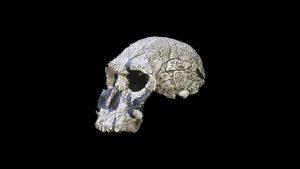
The earliest fossils from the genus Homo are found in eastern, southeastern, and southern Africa. Currently, three species comprise early Homo: Homo rudolfensis (2.5 to 1.8 million years ago), H. habilis (2.1 to 1.5 million years ago, with which H. rudolfensis shares many similarities), and H. erectus (1.8 to 0.9 million years ago). The earliest known species of early Homo, H. rudolfensis fossils are found in Kenya, Ethiopia, and northern Malawi. This taxon displays an intriguing mix of primitive (traits that are shared with an ancestor) and derived traits (traits different from those found in the ancestral species) that make taxonomic and phylogenetic interpretations difficult and controversial.
H. rudolfensis is named for the fossil KNM-ER 1470, found on the east side of Lake Rudolf (now Lake Turkana) in Kenya. KNM-ER 1470 most clearly exemplifies H. rudolfensis and is characterized by a large cranial capacity (around 750 cc), large cheek teeth, and a long face that is broad across the orbits (eye sockets) and flattened below the nose. Brain endocasts (a cast made of the mold formed by the impression the brain makes on the inside of the brain case, providing a replica of the exterior surface of the brain) indicate that Broca’s area, an area of the brain associated with speech, is more clearly developed in H. rudolfensis than in australopiths. However, it must be noted that possessing the neurological architecture (i.e., structures within the brain) for speech does not mean that H. rudolfensis used spoken language. In addition to a large brain, H. rudolfensishas very large (i.e., megadont) premolar and molar teeth (i.e., cheek teeth) similar to australopiths, which has led some researchers to question its inclusion in the genus Homo.
There is controversy over which fossils should be attributed to H. rudolfensis versus H. habilis. There are approximately 200 skeletal fragments that comprise 40 individuals from both species, each with a distinctive mosaic of primitive and derived traits. A minority of researchers feel that the differences between H. rudolfensis and H. habilis are due to differences in size between the sexes of a single species (this is called sexual dimorphism), and thus group all of the fossils together. However, many of the morphological patterns in H. rudolfensis are either opposite of what would be expected for the male of a single sexually dimorphic species or are lacking entirely. Furthermore, while there are postcranial (the skeleton minus the skull) remains for H. habilis (see essay on H. habilis for details on anatomy), there are no postcranial remains associated with known H. rudolfensis crania, so we do not have estimates of body size or proportions for this species.
Further evidence for the distinctiveness of H. rudolfensis and H. habilis comes from dental wear analysis (study of how a tooth is worn down over time), which shows that H. rudolfensis molars were larger and worn horizontally, in contrast to H. habilis whose molars were smaller and show more occlusal relief (complex, less flat topography of the teeth). This fact indicates that H. habilis and H. rudolfensis had significantly different dietary strategies. H. rudolfensis, like Paranthropus, was probably mainly herbivorous and able to cope with tough fruits and plants. H. habilis, by contrast, has dental anatomy that suggests a certain amount of omnivory (consumption of vegetal foods and meat). Over time it has become clear that a differentiation between H. habilis and H. rudolfensis is warranted, as the physical variation between the two is too extensive to be contained within one species.
Interpreting the evolutionary history of early Homo depends upon which traits are emphasized. While H. habilis shows a reduction in tooth size combined with a more australopith-like post cranium, H. rudolfensis has a much larger face and teeth (similar to robust australopiths) combined with a larger brain. If brain expansion is emphasized, then H. rudolfensis would be considered the most likely ancestor to later Homo. However, if a reduction in the face and teeth is emphasized, then H. habilis is the most likely ancestral form. The problem is identifying which traits are homoplasies, that is, identifying which traits are similar due to shared ancestry (homology) versus those that are similar due to exploitation of a similar environment, but not to shared ancestry (homoplasy). For example, if H. habilis is accepted as our direct ancestor, then the large brains of H. rudolfensis and H. erectus would have developed independently. Conversely, if H. rudolfensis is considered ancestral, then its large, broad face and Paranthropus-like teeth would be considered homoplasies.